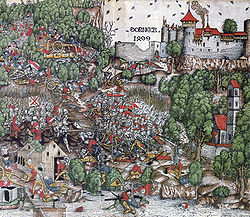
The Battle of Sempach was fought on 9 July 1386, between Leopold III, Duke of Austria and the Old Swiss Confederacy. The battle was a decisive Swiss victory in which Duke Leopold and numerous Austrian nobles died. The victory helped turn the loosely allied Swiss Confederation into a more unified nation and is seen as a turning point in the growth of Switzerland.
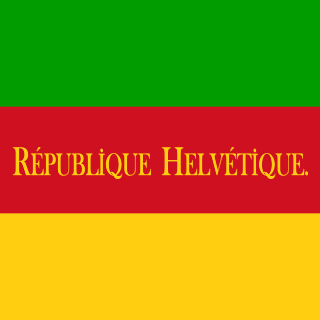
The Helvetic Republic was a sister republic of France that existed between 1798 and 1803, during the French Revolutionary Wars. It was created following the French invasion and the consequent dissolution of the Old Swiss Confederacy, marking the end of the ancien régime in Switzerland. Throughout its existence, the republic incorporated most of the territory of modern Switzerland, excluding the cantons of Geneva and Neuchâtel and the old Prince-Bishopric of Basel.
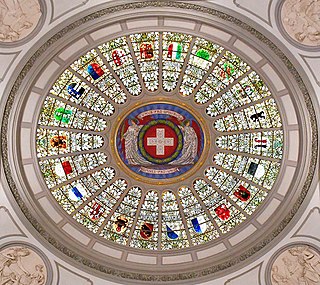
Each of the 26 modern cantons of Switzerland has an official flag and a coat of arms. The history of development of these designs spans the 13th to the 20th centuries.

The Sonderbund War of November 1847 was a civil war in Switzerland, then still a relatively loose confederacy of cantons. It ensued after seven Catholic cantons formed the Sonderbund in 1845 to protect their interests against a centralization of power. The war concluded with the defeat of the Sonderbund. It resulted in the emergence of Switzerland as a federal state, concluding the period of political "restoration and regeneration" in Switzerland.

The Old Swiss Confederacy began as a late medieval alliance between the communities of the valleys in the Central Alps, at the time part of the Holy Roman Empire, to facilitate the management of common interests such as free trade and to ensure the peace along the important trade routes through the mountains. The Hohenstaufen emperors had granted these valleys reichsfrei status in the early 13th century. As reichsfrei regions, the cantons of Uri, Schwyz, and Unterwalden were under the direct authority of the emperor without any intermediate liege lords and thus were largely autonomous.
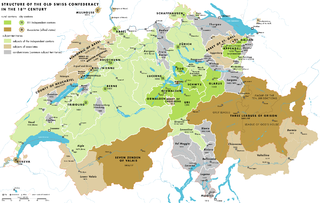
The early modern history of the Old Swiss Confederacy and its constituent Thirteen Cantons encompasses the time of the Thirty Years' War (1618–1648) until the French invasion of 1798.

During the French Revolutionary Wars, the revolutionary armies marched eastward, enveloping Switzerland in their battles against Austria. In 1798, Switzerland was completely overrun by the French and was renamed the Helvetic Republic. The Helvetic Republic encountered severe economic and political problems. In 1798 the country became a battlefield of the Revolutionary Wars, culminating in the Battles of Zürich in 1799.
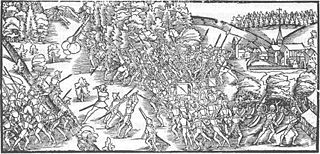
The Second War of Kappel was an armed conflict in 1531 between the Catholic and the Protestant cantons of the Old Swiss Confederacy during the Reformation in Switzerland.
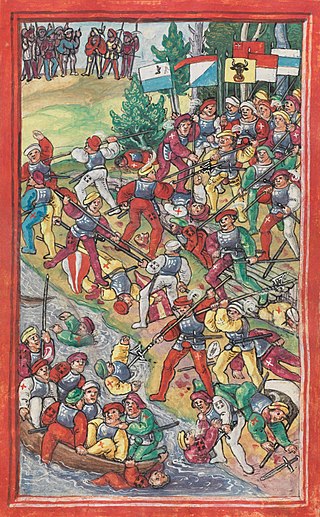
The Swabian War of 1499 was the last major armed conflict between the Old Swiss Confederacy and the House of Habsburg. What had begun as a local conflict over the control of the Val Müstair and the Umbrail Pass in the Grisons soon got out of hand when both parties called upon their allies for help; the Habsburgs demanding the support of the Swabian League, while the Federation of the Three Leagues of the Grisons turning to the Swiss Eidgenossenschaft. Hostilities quickly spread from the Grisons through the Rhine valley to Lake Constance and even to the Sundgau in southern Alsace, the westernmost part of the Habsburg region of Further Austria.
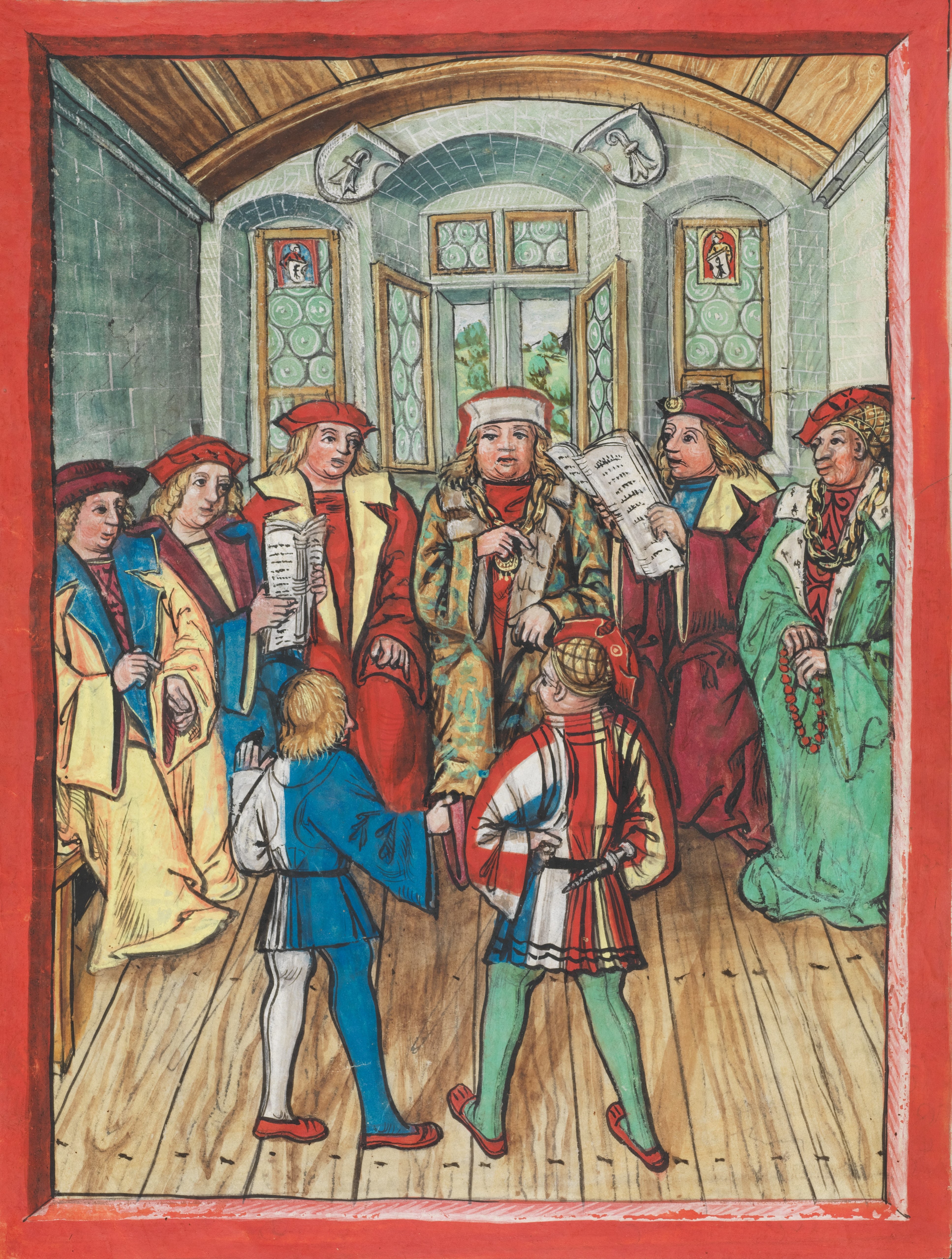
The Treaty of Basel of 22 September 1499 was an armistice following the Battle of Dornach, concluding the Swabian War, fought between the Swabian League and the Old Swiss Confederacy.
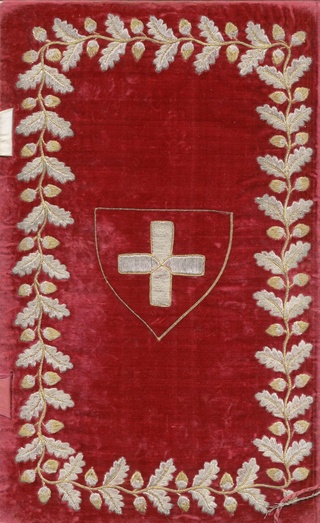
The Federal Treaty was the legal foundation for the new Swiss Confederacy of 1815. It came about after interventions by the great powers of the Sixth Coalition that defeated Napoleon.

The Swiss peasant war of 1653 was a popular revolt in the Old Swiss Confederacy at the time of the Ancien Régime. A devaluation of Bernese money caused a tax revolt that spread from the Entlebuch valley in the Canton of Lucerne to the Emmental valley in the Canton of Bern and then to the cantons of Solothurn and Basel and also to the Aargau.

The Old Swiss Confederacy or Swiss Confederacy was a loose confederation of independent small states, initially within the Holy Roman Empire. It is the precursor of the modern state of Switzerland.

The Battle of Bruderholz took place on 22 March 1499 in the Swabian War between Swabian troops and forces of the Old Swiss Confederacy. The Swabians had raided several Swiss villages and were on their way back when they met troops from Lucerne, Solothurn, and Bern, who also came back from a raid in the Alsace. Anticipating the likely route of the Swabian troops, the Swiss soldiers concealed themselves in the woods at Bruderholz hill, near Basel. When the three times more numerous Swabians passed the woods, the Swiss attacked. The Swabian infantry quickly broke and fled the battlefield. The cavalry fought a delaying action allowing the infantry to escape before retreating also. Some of the fleeing soldiers ran approximately 2 miles (3.2 km) to the Rhine river before swimming across to continue their retreat. Others fled to Basel but were refused entry. The Confederation lost only a single soldier while the Swabians lost about 80 men.

The Battle of Schwaderloh took place on 11 April 1499 near Triboltingen, a village on the Swiss shores of the Untersee just south of Constance. It was one of the major battles of the Swabian War between the Old Swiss Confederacy and the forces of the Swabian League and of Emperor Maximilian I.

The Battle of Calven took place on 22 May 1499 at the exit of the Val Müstair in the Grisons to the Vinschgau in County of Tyrol between the forces of King Maximilian I of the House of Habsburg and those of the free federation of the Three Leagues of the Grisons. It was the decisive battle in the southern Grisons of the Swabian War; after the defeat of the Habsburg troops, the king had to abandon his attempts to control the Engadin and the Val Müstair. The focus of operations in the Swabian War subsequently shifted again to the northern border of the Old Swiss Confederacy.

The French invasion of Switzerland occurred from January to May 1798 as part of the French Revolutionary Wars. The independent Old Swiss Confederacy collapsed from the invasion and simultaneous internal revolts called the "Helvetic Revolution". The Swiss ancien régime institutions were abolished and replaced by the centralised Helvetic Republic, one of the sister republics of the French First Republic.

The Raron affair was a 15th-century rebellion in the Valais against the power of a local noble family, the Raron family. The rebellion brought several cantons of the Swiss Confederation into conflict with each other and threatened a civil war in the Confederation. While Bern was initially successful, they were eventually forced to surrender most of their gains.
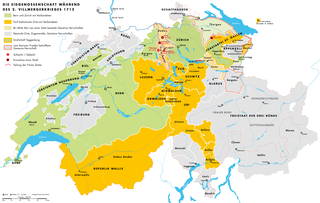
The Toggenburg War, also known as the Second War of Villmergen or the Swiss Civil War of 1712, was a Swiss civil war during the Old Swiss Confederacy from 12 April to 11 August 1712. The Catholic "inner cantons" and the Imperial Abbey of Saint Gall fought the Protestant cantons of Bern and Zürich as well as the abbatial subjects of Toggenburg. The conflict was a religious war, a war for hegemony in the Confederacy and an uprising of subjects. The war ended in a Protestant victory and upset the balance of political power within the Confederacy.

The Second Battle of Ulrichen was a battle fought in 1419 between the Old Swiss Confederacy lead by Bern and rebels from Valais near Ulrichen in the district of Goms in the canton of Valais in Switzerland. Negotiations after the battle led to the end of the Raron affair and self-determination for Valais.
